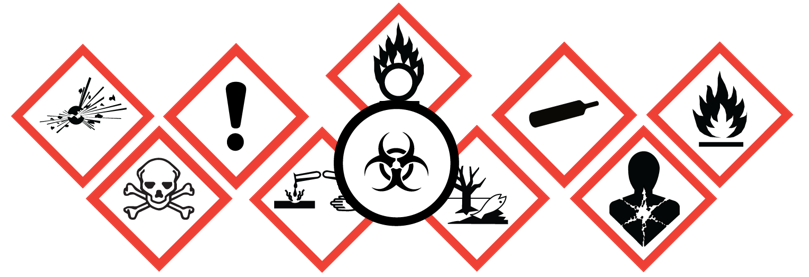GHS Labels
Regulations Involved
GHS stands for the Globally Harmonized System of Classification and Labelling of Chemicals. Examples of GHS label implementation include Occupational Safety and Health Administration (OSHA) for the United States; Workplace Hazardous Materials Information System (WHMIS) for Canada; and the Classification, Labelling and Packaging (CLP) Regulation for the European Union.
The first edition of GHS labeling was adopted in December 2002 and published in 2003 by the United Nations. Since first being implemented, GHS labels have been continually updated and revised. The system ensures that information on health, physical, and environmental hazards is available to the users. GHS has been adopted by many countries around the world and allows for the harmonization of hazard communication elements. It also provides the basis for alignment of rules and regulations for chemicals both nationally and internationally.
Who Does This Apply To?
These regulations apply to products that require industrial workplace labelling. Depending on the classification of the product, the GHS label elements will include a signal word, pictogram, hazard statements, and precautionary statements. Other required information such as the product identifier, supplier information, and supplementary information are also included. Some countries will also have specific label requirements, such as minimum pictogram sizes or a requirement to list hazardous chemicals on the label, as applicable.
Is This Regulation Mandatory?
In most countries, hazardous substances and mixtures used in the workplace are required to have a GHS label to inform users about the hazards and necessary precautions for safe use.
Even though GHS labeling itself is a voluntary system adopted by countries around the world, it is important to comply with the country specific regulations to ensure that the products are properly labeled and contain the necessary label elements. The focus is to ensure that the hazard information is available to help protect human health and the environment.
What are the risks if a company chooses not to comply?
The risks if a company chooses not to comply could include worker accidents and unintended exposure to hazardous chemicals. By complying with GHS, the intent is to reduce the likelihood of serious injury in the workplace. Noncompliance could also result in significant fines and penalties, or possible product recalls from the market.
The workplace is responsible for providing GHS labels to its employees. This information is typically provided by the manufacturer of the products. The employer must ensure that all GHS labels are easily readable and are replaced if damaged or lost.
How Can Nexreg Ensure Your Compliance?
Nexreg will first review the product information to determine the associated GHS hazards. We request that the full formula be provided, as well as other information including the current safety data sheet (SDS) and any known physical data.
The product information is evaluated, and a label memo is generated in the required language and format for the requested country.
A consultant will then review the label to ensure accuracy. The final product, is a GHS label memo available in Word or PDF format, containing all the required information and elements that must appear on the workplace product. You can directly print this GHS label for application to the product package, or you can take the information for incorporation into label artwork design.
The GHS label should match section 2 of the product SDS, therefore, Nexreg can also provide the SDS generation service if needed.
Label checks of the final artwork can be performed by Nexreg. We advise clients take advantage of this service before printing their first labels.

